Some Blood Indicators in Stallions When Using Different Doses of Lyophilized Damiana De California (Turnera Diffusa Willd)
Néstor Méndez Palacios1*, Felicitas Vazquez Flores1, José Alfredo Galicia Domínguez1, Netzi Naidí Méndez Palacios1, Guillermo Ramón Pardo Cardoso2 and Y Maximino Méndez Mendoza1
1Faculty of Veterinary Medicine and Zootechnics, Tecamachalco-Cañada Morelos, University of Puebla Mexico
2Faculty of Agricultural Sciences, University of Camaguey, Cuba
Submission: July 02, 2023; Published: July 13, 2023
*Corresponding author: Néstor Méndez Palacios, Faculty of Veterinary Medicine and Zootechnics, Tecamachalco-Cañada Morelos, University of Puebla Mexico, Email id: nmp63mx@gmail.com
How to cite this article: Néstor M P, Felicitas Vazquez F, José A G D, Netzi N M P, Guillermo R P C, et al. Some Blood Indicators in Stallions When Using Different Doses of Lyophilized Damiana De California (Turnera Diffusa Willd). Ann Rev Resear. 2023; 9(4): 555767. DOI: 10.19080/ARR.2023.09.555767
Keywords: Leukocytes; Erythrocytes; Hematocrit; Hematological parameters; Daidzein injection; Phytogenic additive (oregano); Total Proteins; Urea; Caratini; Glucose; Cholesterol
Introduction
One of the most effective ways in which healing or stimulant elements that are quickly assimilated by animals can be incorporated are intramuscularly injectable substances, producing immediate responses. Damiana de Californaia (Turnera difuse Wild) is a shrub, according to Argueta et al. [1]; Monroy & Castillo [2], mention that the leaves contain an essential oil in which monoterpenes 1-8-cineole have been identified., paracymene, alpha and beta-pinene, and the terpenoid (β sitosterol), the flavonoid gonalities, caffeine, the alkanes hexacosanol, n-triacontane and tricosan-2-one, resins, tannins and a bitter principle. With the premise of its possible induction of hormonal secretion, in addition to intervening in metabolism, accelerating growth or reproduction, Chevallier [3]; Mendez [4]. Taking into account what has been previously indicated, the objective of this work was to evaluate the use of this lyophilized plant with a view to assessing the possible blood alterations that it could cause.
Materials and Methods
The study was conducted in Tecamachalco, Puebla, Mexico. Located at 18º 52’ 57’’ parallels, North Latitude and 97º 43’ 49’’ West Latitude, at an altitude of 2055 meters above sea level, with a semi-dry temperate climate and annual rainfall of 700 mm (Encyclopedia of Municipalities, Ministry of the Interior, 2005). Six Pietrain Stallions used for artificial insemination of 1.5 - 2 years of age with an average weight of 150 ± 4.5 kg were used.
Procedure in the selection of samples and application of the treatment
The six selected stallions were distributed in boxers individually, supplying them with food in the morning (9 a.m.) and afternoon (5 p.m.) hours. The scheme of the statistical design used is shown in (Table 1), which corresponds to a Double Balanced Latin square to evaluate the residual effects and with an Extra Period that allows to orthogonalize the residual effects. Within each Period, each animal was injected with the proposed dose of the Biostimulator in the neck, in the morning and four applications, at 0 - 7 - 14 - 21 days, to subsequently use 21 days of resting, which meant that each period was 42 days for a total of 168 experimental days. Blood extractions were made on days 0 - 14 - 21 before inoculating the product. The distilled water used was the same used in dissolving the lyophilized biostimulator.
Treatments used: the following levels of the factor under study were used:
a) Production conditions + 0 mL of Damiana + 8 mL of distilled water.
b) Production conditions + 8 mL of lyophilized biostimulated Damiana.
c) Production conditions + 12 mL of lyophilized biostimulated Damiana.
i. Experimental unit = 1 animal
ii. Repetitions =Each extraction performed on each stallion (18/animal) in the case of blood and 28/animal in the case of semen.
Statistical Procedure
For the statistical decisions, all the indicators evaluated in each experimental unit were classified according to the following criteria.
Hematology (Leukocytes, Erythrocytes, Hematocrit and Hemoglobin)
Blood Chemistry (Total Proteins, Urea, Caratini, Glucose and Cholesterol)
From the grouping according to the aforementioned criteria, the techniques proposed by Pardo et al. [4] were applied to each group of these variables with a view to guaranteeing the independence of each one using the Principal Components, (Annex 1) to the variables obtained and expressed in (%), assigning the respective mean to each period, all this using the statistical package SPSS (2001). Assigned to each period the aforementioned value, these were statistically processed by means of a Balanced Latin Square with residual effects and an extra period, using the Residuals software (1999). For the evaluation of the results, significance was used as a criterion for a level of 5% of the (E.D.A.. Annex 2), reporting the adjusted direct values, which are free of residual effects.
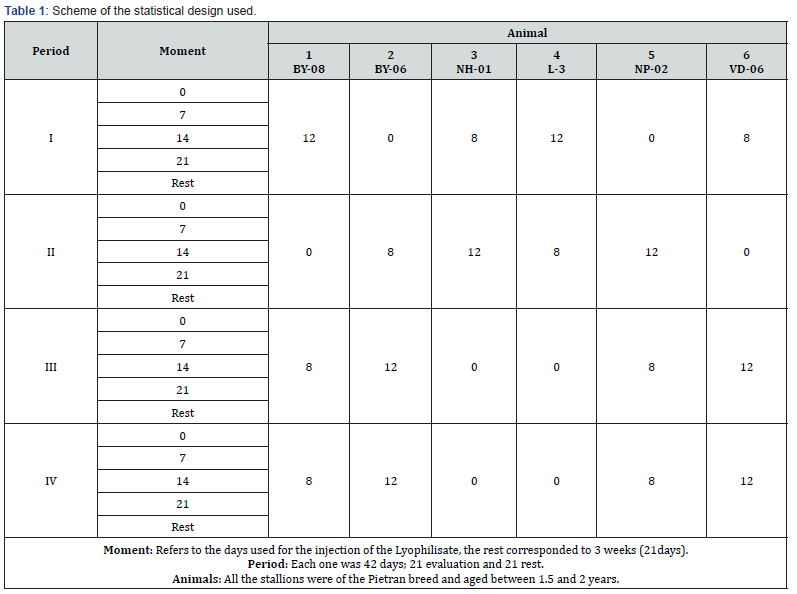
Results and Discussion
Hematology
The hematic picture in the experimental animals (Table 2), revealed how the clinical indicators of the fundamental health status, leukocytes, erythrocytes and hematocrit, are within the normal range for pigs of this age Gajecki et al. [5], note how its efficiency is within the 95% confidence range for all levels of injectable lyophilized Damiana used. These results allow us to infer that there is no risk to animals by supplying this product.

It should be noted that the level of hemoglobin efficiency, although it differs significantly, due to the use of biostimulated and lyophilized Damiana from California (Turnera diffuse Willd), presents quite low values with respect to the optimum for this type of animal. If it is taken into account that these animals have an adequate development, and a mating rate of 2 times a week, it requires that the level of food used be optimal in order to establish a metabolic rate that guarantees the presence of oxygen Rolo et al. [6], occurring in this case what was suggested by Novikova et al. [7] about animals with nutritional deficiency that tend to improve their hematological parameters slowly although they maintain their reproductive rhythm from their reserves. On the other hand, Wang et al. [8] using the Daidzein injection, were able to stimulate the growth and development of pigs, suggesting that white blood cells could be increased, although this is not frequent, having no impact on red blood cells, which does not agree with the results obtained with the lyophilized biostimulated Damiana de California. As it has been possible to verify the Damiana de California (Turnera diffusa Willd), in the stallions used it did not produce modifications in the hematological indicators evaluated that suggest a possible effect on their health.
Chemical components of blood serum
The behavior of the blood serum when inoculating the California Damiana (Turnera diffusa Willd), biostimulated in the experimental animals is observed in (Table 3), note that the nutritive and residual nitrogenous elements were not significantly affected by the injection of this product. This result confirmed to a certain extent that the low temperature treatment to which fresh Damiana was subjected and its subsequent lyophilization does not affect the animals, that is, it does not compromise the chemical indicators of the blood serum that suggest any metabolic and nutritional deficiency in the animals. On the other hand, assessing that this catalyst product contained in the biostimulated Damiana of California (Turnera diffusa Willd) would be responsible for the increase in hormonal activity and that it probably produces an increase in its blood levels, as suggested by Ferguson et al. [9] by supplying tryptophan in backward young pigs causing action on the synthesis of serotonin, causing regulating hormonal increases in the appetite of pigs at this age and therefore probably increases in globulin levels which must be increased and consequently that of the total proteins reported by the chemical analysis, in addition to the decrease in cholesterol according to Eder et al. [10] indicates the existence of the relationship between the thyroid hormone and the compound metabolism, but relating it to those foods that present oxidized oils, which has not happened in this case, since they were used during this experiment with value res of ethereal extract corresponding to the requirements of this stage NRC [11].
If a metabolic indicator is analyzed that in small quantities produces important responses in the animal and that probably corresponds to one of the actions of cyclic AMP that refers to the increase in stereogenesis, since we must not rule out the conversion of cholesterol into pregnenolone, stimulating the action of 20 hydroxylase that catalyzes the separation of the cholesterol side chain between its carbons 20 and 22, as one of the points of action of ACTH and gonadotropins on steroidogenesis, consequently causing a decrease in the values of this indicator. Herskin & Jensen [4] refer to the fact that the exposure of these animals subjected to different handling and blood extraction causes an increase in adrenocortical activity, causing an increase in this product. Also, Bauer et al. [2] when using a phytogenic additive (oregano) obtained variations in the cholesterol content. Taking into account the above and the results obtained in blood nutritive elements (Z1q) would justify to a certain extent the very low performance obtained in this indicator (Glucose, Cholesteron and Total Proteins); however, Grela et al. [12] referring to the effectiveness of herbal or plant additives (phytogenic) in pigs, they report their blood indices as normal [13,14].
In summary, it can be expressed that according to the results obtained in the blood tests carried out, the use of biostimulated and freeze-dried Damiana de California (Turnera diffusa Willd) has not affected the clinical indicators that indicate deterioration of health due to its intramuscular inoculation. However, in pigs, although they present blood serum indicators within normal parameters, a low efficiency is observed, which, although the product used is not responsible, does seem to be caused by the intensive management to which they were subjected during the experimental stage and the nutritional quality of the feed used (Annex 1-4).
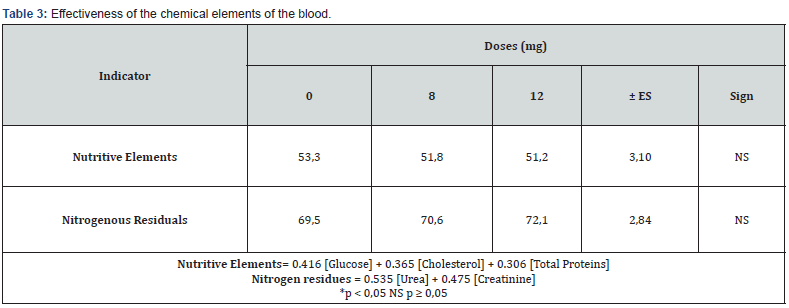

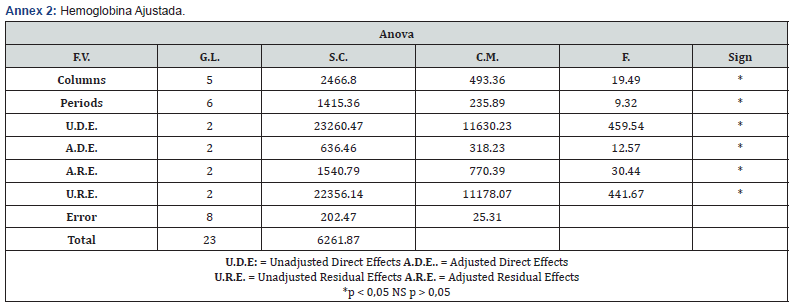
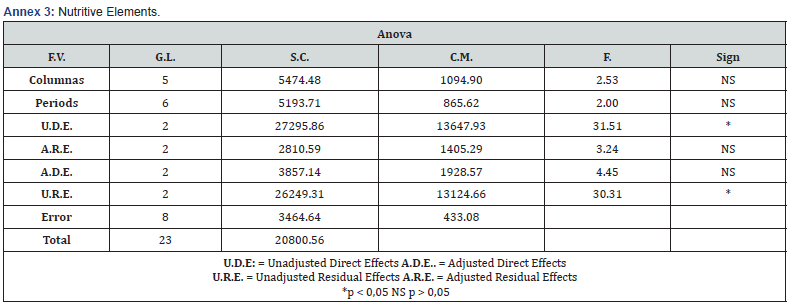
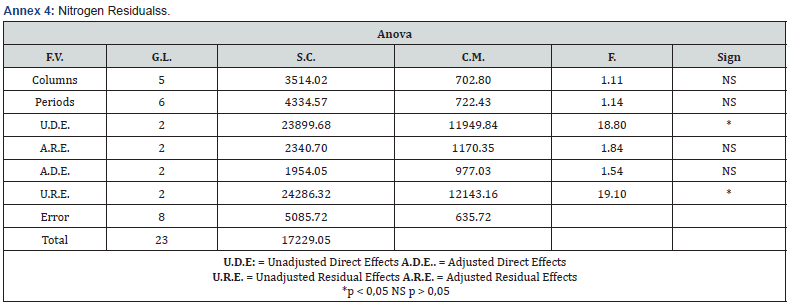
Conclusions
i. The clinical indicators of the fundamental health status, leukocytes, erythrocytes and hematocrit, are within the normal range for pigs of this age.
ii. Hemoglobin, differs significantly, due to the use of biostimulated and freeze-dried Damiana from California (Turnera diffusa Willd), presented low values.
iii. Hemoglobin, differs significantly, due to the use of biostimulated and freeze-dried Damiana from California (Turnera diffusa Willd), presented low values.
iv. According to the results obtained in the blood tests carried out, the use of biostimulated and lyophilized Damiana de California (Turnera diffusa Willd) has not affected the clinical indicators that indicate deterioration of health due to its inoculation by intramuscular route.
References
- Argueta VA, Cano ML, Rodarte ME (1994) Atlas de las plantas de la medicina tradicional mexicana I. Instituto nacional indigenista (INI).
- Monroy OC, y Castillo EP (2000) Plantas Medicinales utilizadas en el estado de Morelos: Centro de Investigaciones Bioló Universidad Autónoma de Morelos, México.
- Bauer F, Siller D, Kleineisen S, LUF W (2002) The influence of feeding sage and oregano on the oxidative stability of raw belly bacon.
- Herskin MS, Jensen KH (2002) Effects of open field testing and associated handling vs handling alone on the adrenocortical reactivity of piglets around weaning. J Anim Sci 74(3): 485-491.
- Gajecki M, Malinowski, Pirus K, Zielonkt, Bakula, et al. (1998) Metabolic profile of sows in the second and fourth week of lactation in a herd endemically infected with PPV. Proceedings of the 15th IPVS Ciongress Birminham England 5(9): 52.
- Rolo M, López N, Palencia L, Sandoval A, Peroza L (2000) Hematology and blood chemical values in swine of Venezuela. The 16th International Pig Veterinary Society Congress (IPVS), Melbourne, Australia 17(20): 314.
- Novikova N N, Ernst LK, Gegamian NS, Kovaleva OV (2001) The use of paraaminobenzoic acid for the prophylaxis of diseases and stimulating the growth of piglets. Russian Agricultural Sciences 12: 46-49.
- Wang Genlin, Zhang Xiangying, Han Zhaoyu, Liu Zhaobin, Liu Weirong (2002) Effects of daidzein on body weight gain, serum IGF-I level and cellular immune function in intact male piglets. Asian-Australasian Journal of Animal Sciences 15(7): 1066-1070.
- Ferguson NS, Lavers G, Gous RM (2001) The effect of stocking density on the responses of growing pigs to dietary lysine J. Anim Sci 73(3): 459-469.
- Eder k, Stangl GI (2000) Plasma thyroxine and cholesterol concentrations of miniature pigs are influenced by thermaly oxidized dietary lipids. J Nutr 130(1): 116-121.
- NRC (National Researh Council) (2004) Nutrient Requirements of Beef Cattle. Seventh Revised Edition. Update. Nat Acad Press Washington DC USA.
- Grela ER, Kumek R (2002) Effect of feed supplementation with phytase and formic acid on piglet performance and the composition of sow colostrums and milk. Medycyna Weterynaryjna 58(5): 375-377.
- Chevallier A (1996) The Encyclopedia of Medicinal Plants. Dorling Kindersley London.
- Méndez MM, Pardo CG, Huerta CR, Avilés BR, Martínez VM (2002) Efecto de un liofilizado de damiana de California (turnera difusa willd, variedad afrodisíaca), en cerdos de 30 a 60 días de edad: II.- Química sanguínea y hematología: XVIII Congreso Panamericano de Ciencias Veterinarias. La Habana, Cuba.






























